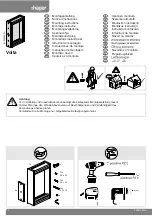
2 Functions
52
6MD665 Manual
C53000-G1876-C103-3
The Dead bus and Dead line connection are special cases. In this case, connection
is made depending on the configuration under the following conditions:
• Dead Line | U
pp
| >
8PLQ
and | U
line
| <
8GHDG
and
IPLQ
≤
f
pp
≤
IPD[
• Dead bus | U
pp
| <
8GHDG
and | U
line
| >
8PLQ
and
IPLQ
≤
f
line
≤
IPD[
• Dead line & Dead bus | U
pp
| <
8GHDG
and | U
line
| <
8GHDG
Busbar voltage U
pp
and feeder voltage U
line
are assigned to voltages U1 and U2
depending on how the device is connected. Connection examples can be found in the
Appendix.
The connection is performed on an idle busbar, on an idle feeder or on both.
A synchronisation comparison with the runtime of the synchronisation function can
be executed by means of definitely applied voltages (normal case) or by means of a
voltage application via relay.
The synchronisation comparison including an application of the voltage is necessary
e.g. for multiple busbars or in case of a failure of the coupling circuit breaker (backup
switching). Additional preparatory switching operations as well as the selection of the
subsettings group are necessary for applying the voltage at the time of the compari-
son. The settings must be stored in the control device for each combination of subnet-
works.
The measuring channels of the reference and feeder voltage must be assigned to
each synchronisation module individually.
Voltage application
If the voltage application is used, the user must set a switching sequence with the fol-
lowing components:
• Voltage application
• Synchronisation
• Voltage deselection
The voltage application option ensures that a 250 ms delay is considered in the mea-
suring algorithm after the synchronisation start. In this way, the measured values can
stabilize.
Field of application
internal control,
internal synchroni-
sation
The synchronisation with internal control and internal synchronisation is the standard
application with 6MD665. Maximally 8 synchronisation modules (SYNC functions
group 1 to 8) with different settings groups are available.
The assignment of the synchronisation-requiring control device to the corresponding
synchronisation settings group is performed via the
6\QF6'
setting (control device to
be synchronised).
At the time of the switching operation, the module selection can be controlled dynam-
ically via the Sync. effective input message. The Sync. effective input message can
be configured to a binary input, CFC or IRC. Unsynchronised switching is performed
if no synchronisation function is effective (Sync. effective OFF).
In this case, the contact between the control and the synchronisation function is per-
formed internally via messages:
•
´!6\0HDVµ
(Measurement request)
•
´6\QF&ORVH5HOµ
(Enable switch-on)
•
´6\QFV\QFKURQµ
(in case of an error)
Содержание SIPROTEC 6MD665
Страница 8: ...Preface vi 6MD665 Manual C53000 G1876 C103 3 ...
Страница 14: ...Contents vi 6MD665 Manual C53000 G1876 C103 3 ...
Страница 140: ...3 Installation and Commissioning 126 6MD665 Manual C53000 G1876 C103 3 ...
Страница 166: ...4 Technical Data 152 6MD665 Manual C53000 G1876 C103 3 ...
Страница 201: ...A 9 Group Alarms 187 6MD665 Manual C53000 G1876 C103 3 A 9 Group Alarms No Description No Description ...
Страница 210: ...Literature 196 6MD665 Manual C53000 G1876 C103 3 ...
Страница 222: ...Index 208 6MD665 Manual C53000 G1876 C103 3 ...
















































